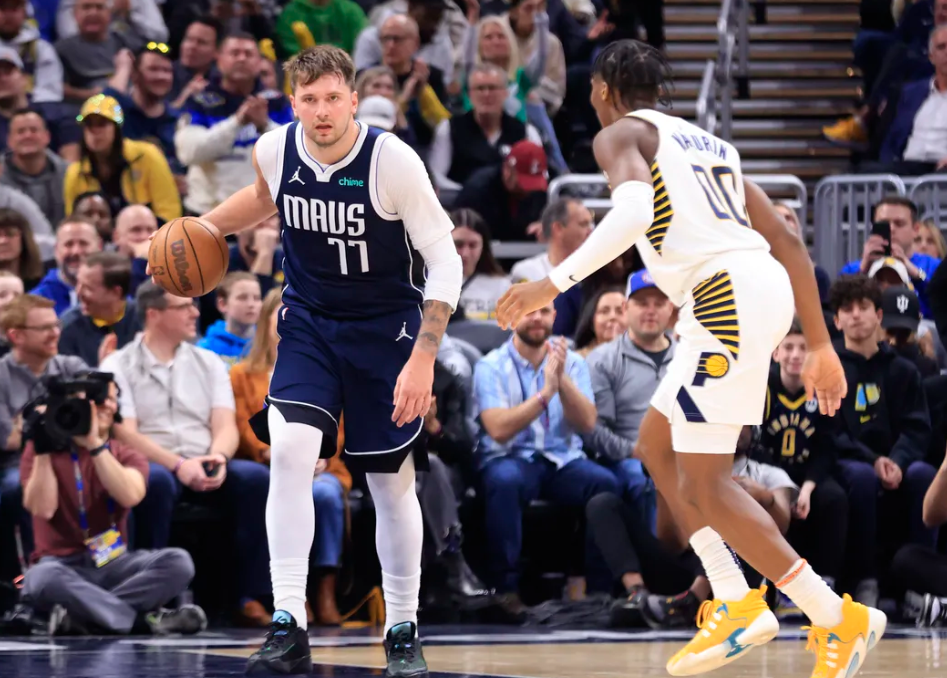The Dallas Mavericks suffered a 133-111 defeat at the hands of the Indiana Pacers in a game marked by sloppiness and disarray on the Mavericks’ part. Throughout the evening, they appeared a step behind Indiana, especially evident in the disappearance of their previously impressive defense, a key element during their recent seven-game win streak.
Despite another standout performance from Luka Doncic, displaying MVP-level skills, the rest of the team failed to step up. Kyrie Irving showed some spark early in the fourth quarter, but it proved insufficient as the Mavericks found themselves outplayed on both offense and defense. This loss stings particularly as the Western Conference standings resemble a fiercely competitive scenario, with Dallas missing an opportunity to climb to the fifth seed, now finding themselves back in contention for the play-in games. Here are three noteworthy statistics from this disappointing loss:
- 27.8: Combined field-goal percentage for Tim Hardaway Jr. and PJ Washington The duo had a rough night, shooting a mere 5-of-18 from the field, including 3-of-9 from three-point range. In assessing blame for the loss, Hardaway and Washington stand out. Hardaway struggled with his shot, going 1-of-6 from two-point range, committing four turnovers, and displaying subpar defense. His shot selection often favored Indiana, swinging momentum against the Mavericks.Washington, too, appeared lost on offense, notably in his inability to convert from beyond the arc. His four turnovers, some of them costly, compounded the issue. For two players who don’t create much with the ball, eight combined turnovers are unacceptable. While Washington held his ground defensively, his performance didn’t sway the game as in previous outings. It was a tough night for these crucial Maverick role players, with a call to limit Hardaway’s minutes and a necessity for Washington to find his shooting touch to avoid stifling Dallas’ potential.
- +15: Pacers’ advantage in fast-break points Indiana, ranking fifth in the NBA for fast-break points per game, executed their strategy to perfection, pushing the pace and capitalizing on transition opportunities. Initially, Dallas managed to keep pace and hold a slight lead. However, Indiana’s relentless approach eventually wore down the Mavericks, forcing them to play catch-up in a style dictated by the Pacers. Dallas’ defense faltered in meeting this challenge, lacking the necessary intensity from the game’s start.
- +23: Pacers’ advantage in assists Indiana’s 38 assists far surpassed Dallas’ meager 15, a season-low for the Mavericks. This statistic aligns with the observation that, apart from Luka Doncic, the team struggled to find consistent scoring options. The lack of off-ball movement hindered their offense, as Pacers defenders focused on containing Maverick shooters, content to let Doncic shoulder the scoring burden. Jason Kidd’s coaching adjustments seemed lacking in response to this defensive approach.Tim Hardaway’s dislike for Allen Iverson’s crossover dribble, while not hatred towards Iverson himself, is a notable anecdote. Hardaway, once poised as a potential star point guard in the 1990s, saw his career trajectory altered by injury just as Iverson rose to prominence with his signature move. Iverson’s legendary crossover became a sore point for Hardaway, fueling a longstanding (albeit petty) rivalry based on basketball moves.Meanwhile, Rick Carlisle’s offensive strategy shone for the Pacers, with ball movement dissecting the Maverick defense and creating numerous open shots. Seven Pacers scored in double digits, led by Myles Turner’s 33 points. The contrast was stark between the Pacers’ structured offensive plan and the Mavericks’ reliance on individual brilliance, emphasizing isolation plays or basic pick-and-rolls.
